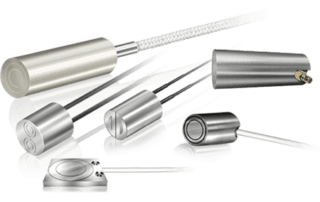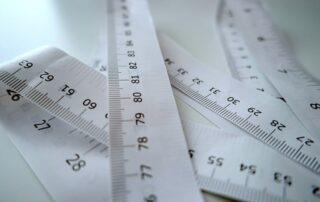Blogs
2D-3D Laser Measurement
ProTrak G: 2D/3D Laser The ProTrak G series are compact profiling sensors that fit in tight spaces. These 2D/3D sensors provide accurate profiling, height, width and positioning measurement using the latest CMOS technology with fast measuring rate of up to 4,000 Hz. View Product ProTrak HD: 2D/3D Laser The ProTrak HD long range profiling laser displacement sensor is built to satisfy the most demanding automated dimension, angle, curvature and height in the industrial application. At a fast speed of 6,000 frames per second and up to 2.5µm resolution, it also has measuring of up to [...]
Capacitance Displacement and Gap Measurement Probes
High resolution, low cost sensors to measure gap and displacement in industries such as semiconductor, electronics, R&D applications and many more. REQUEST A QUOTE For grounded targets MTI offers standard capacitance probes. For ungrounded or poorly grounded targets MTI offers push/pull dual sensor probes. Both types of probes are available in stainless steel construction or flat and flexible polyimide construction. Polyimide flat probes are perfect for gap applications or confined spaces. Learn more about our capacitance probes in these brochures: ACCUMEASURE Capacitance Probes for ACCUMEASURE D-series Standard Capacitance Probes Push-Pull Probes Brochure MTI Instruments Flat Capacitance [...]
15 Measurement Activities for Students
Image Source: Pixabay 15 Measurement Activities for Students Written by: Tiffany Chambers Did you know we measure things every day without realizing we do so?Whether we’re measuring how much sugar to add to a cake or figuring out how many more miles we can drive before our car needs an oil change, we’re constantly measuring things. Allowing your children and students to measure alongside you will prepare them for the real world. We assembled a list of fun measurement activities for your kids right at home and in the classroom. These activities require little in terms of [...]
Selecting a Displacement Sensor / Measuring System
Capacitive displacement sensors Capacitive displacement sensors are non-contact devices that are used for measurements at a high-resolution. It can also be used to check the position of any conductive object as well as measure the width or density of non-conductive materials. Capacitive displacement sensors have a large variety of uses including precision thickness measurements, assembly line testing, assembly metrology, and semiconductor processing. Capacitive displacement sensors can be found in manufacturing facilities all around the globe. There’s more to selecting the proper type of displacement sensor and measurement system than meets the eye. To select the appropriate type of device [...]
International System of Units (SI)
International System of Units (SI)
Target Material and Characteristics
Target Material and Characteristics Transparent/Opaque Targets There are a number of measurement systems that are capable of measuring a target that is opaque. When it comes to transparent targets, the measurement system being used must match the material of the target being measured. For example, if you’re attempting to measure plastic you should use a contact-type measurement system such as a micrometer. When performing a soft target measurement, such as film, a non-contact measurement system (such as a laser displacement sensor) should be utilized. Hard/Soft Targets Objects made out of hard material (such as a block of wood), would [...]
Tolerance and Measurement Accuracy
Tolerance Tolerance refers to the total allowable error within an item and is specifically represented with the symbol +/-. During the manufacturing process it’s almost inevitable that items on the line can become damaged at one point or another. Products can face damage in multiple ways. For instance, changes in temperature and humidity can cause a product to become warped and disfigured. Warping can also occur if there’s improper feedback from the process control device. No matter the reason, it has become necessary to take any and all errors into consideration during the manufacturing and inspection processes. When used [...]
Measurement Errors
Measurement Errors At some point in the manufacturing process you’ll find that differences in measurement results (measured values) will begin to show up due to one error or another. A variety of issues can contribute to a measurement error. As a result you need to have countermeasures in place so that you’re prepared. If you encounter a measurement error, it’s vital that you examine the cause of the error very carefully before using a countermeasure. Keep this in mind if you wish to maintain the quality of your product. Types of Errors in a Measurement System Gross Errors – [...]
Measurement Errors
Measurement Errors At some point in the manufacturing process you’ll find that differences in measurement results (measured values) will begin to show up due to one error or another. A variety of issues can contribute to a measurement error. As a result you need to have countermeasures in place so that you’re prepared. If you encounter a measurement error, it’s vital that you examine the cause of the error very carefully before using a countermeasure. Keep this in mind if you wish to maintain the quality of your product. Types of Errors in a Measurement System Gross Errors – [...]
What is Measurement?
What is Measurement? Measurement is about determining the quantifiable attributes of a target object. Examples of these attributes include: length weight distance thickness position capacity size The following sections explain more about what measurement is – and isn’t. Why is measurement misunderstood? Sometimes, people use the term “measure” instead of “calculate” or “quantify”. All these terms are related, but they’re not the same. For clarity’s sake, think of measurement as a single action that you perform with instrumentation. Collectively, “instrumentation” describes devices (i.e., instruments) that measure, indicate, and sometimes record values. Today, there are many different types of specialized [...]



